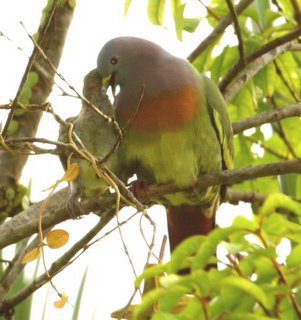Pink-necked Green Pigeons 4: The birds have flown the nest
 The following information comes from observations conducted in February 2005 on a nesting pair of Pink-necked Green Pigeons (Treron vernans) in my garden (see 1 and 2). It is reported here to provide conclusion to the series.
The following information comes from observations conducted in February 2005 on a nesting pair of Pink-necked Green Pigeons (Treron vernans) in my garden (see 1 and 2). It is reported here to provide conclusion to the series.Egg incubation took 17 days. The newly hatched nestling was near-naked, sparsely covered with short pin feathers. The two large and prominent eyes were closed. As with the eyes, the large beak was similarly out of proportion to the body. On the second day, more pin feathers sprouted, as well as the beginning of black primary feathers and a few yellow ones. On day three the eyes were opened and on day six the nestling was totally covered with feathers. A day later the nestling was observed to actively preen its feathers and exercising its wings. The nestling was restless, moving around the nest while the parent bird sat quietly still.
As in egg incubation (see 3), the male looked after the nestling during the day and the female during the night. Both parents helped feed the nestling.
As the nestling grew older, it exercised its wings by flapping them, especially when the wind blew through the tree. The nestling fledged at 10 days, leaving the nest to eventually find it way to a nearby mempat tree (Cratoxylum formosum). The male parent was seen sitting beside the fledgling, feeding it whenever the latter begged by pecking its parent’s neck. Sometimes the fledgling used its wing to harassed the parent bird for food. According to the literature the fledgling is fed with regurgitated fruits, not crop milk.
 The pair remained on the same branch until evening. The next morning the male bird was still at it side. The female must have left early. By late afternoon the male bird left the fledgling alone before the arrival of the female. Some evenings both parent birds would vocalize, cooing and making rasping sounds as well as flapping their tails. The fledgling would suddenly appear from hiding and all three would fly off. Whether the fledgling was left along during the day or the male was accompanying it, I am unable to say. Similarly I am ot able to say what happened during the night.
The pair remained on the same branch until evening. The next morning the male bird was still at it side. The female must have left early. By late afternoon the male bird left the fledgling alone before the arrival of the female. Some evenings both parent birds would vocalize, cooing and making rasping sounds as well as flapping their tails. The fledgling would suddenly appear from hiding and all three would fly off. Whether the fledgling was left along during the day or the male was accompanying it, I am unable to say. Similarly I am ot able to say what happened during the night.With each day the birds would fly further and further away from the nesting area, no doubt until the fledgling totally mastered its ability to fly.
In all, I had been observing these birds for nearly a month, All the time, while the birds were in the nest, I was keeping close watch behind a canvas hide twice a day to record the shift change. Naturally when they all left the scene I was left with an empty feeling – to await the next time a pair nest in the tree again.
Note: Birds' nests and the birds in them should not be disturbed unnecessarily, otherwise there is always the possibility of the parent birds suddenly abandoning the nestlings.
For a complete account, please see: Wee Y.C. (2005). Forging a closer relationship with Pink-necked Green-pigeons. Nature Watch 13(3): 16-21.
Labels: Nesting



1 Comments:
many a times, when someone try to observe bird nesting or photograph the nesting activity, we can learn so much from the observation. i have been looking for nesting birds to learn something new about a particular bird, even if it is just a common garden birds. thanks for sharing all this information.
Post a Comment
<< Home